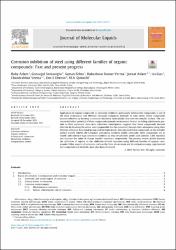| dc.contributor.author | SERDAROĞLU ,Goncagül | |
| dc.date.accessioned | 2023-04-11T05:34:50Z | |
| dc.date.available | 2023-04-11T05:34:50Z | |
| dc.date.issued | 2022 | tr |
| dc.identifier.uri | https://hdl.handle.net/20.500.12418/13472 | |
| dc.description.abstract | Application of organic compounds as corrosion inhibitors, particularly heterocyclic compounds, is one of
the most economical and effective corrosion mitigation methods of steel alloys. These compounds
become effective by forming a corrosion inhibitive hydrophobic film over the metallic surface. The corrosion
inhibition potential of these compounds depends on numerous factors, including substituents present
in their molecular structures. Literature investigation suggests that these compounds become
effective by blocking the active sites (responsible for the corrosion) through their adsorption using their
electron-rich polar functional groups and multiple bonds. Adsorption of these compounds on the metallic
surface mostly follows the Langmuir adsorption isotherm model. Generally, these compounds act as
mixed- and interface-type corrosion inhibitors as they retard both anodic and cathodic Tafel reactions
and increase the value of charge transfer resistance, respectively. The present review article features
the collection of reports on the inhibition of steel corrosion using different families of organic compounds.
Other aspects of corrosion, such as the form of corrosion and its mitigation using experimental
and computational methods, have also been discussed. | tr |
| dc.language.iso | eng | tr |
| dc.rights | info:eu-repo/semantics/openAccess | tr |
| dc.title | Corrosion inhibition of steel using different families of organic compounds: Past and present progress | tr |
| dc.type | article | tr |
| dc.contributor.department | Eğitim Fakültesi | tr |
| dc.identifier.volume | 348 | tr |
| dc.identifier.endpage | 118373 | tr |
| dc.identifier.startpage | 118373 | tr |
| dc.relation.publicationcategory | Uluslararası Hakemli Dergide Makale - Başka Kurum Yazarı | tr |















